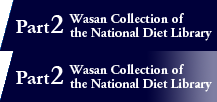Chapter 1. Early Edo Period
Column Influences from Chinese Mathematics (Level 0)
As imported languages from China to Japan were used for the notation of numbers, the names of large numbers, and the calendar systems in ancient Japan, we could say that the Japanese mathematics started from the importation of its Chinese counterpart.
The two writings Zhoubi suanjing and Jiuzhang suanshu remain with us in book-form and are known to us as ancient mathematical books; however, neither their authors' names nor the years they were written are known.
The first famous Chinese mathematician whose name is known to us is Liu Hui from the Wei kingdom, who brought about great progress such as the adoption of 3.14 for Pi (the ratio of the circumference of a circle to its diameter) in his annotation to Jiuzhang suanshu. That occurred during the time of the Yamataikoku in Japan. During the Tang Dynasty, these books, together with other mathematical books, were incorporated into a textbook for training bureaucrats called Stum jing shi shu. These textbooks were then introduced into Japan as part of the Chinese bureaucracy, a fact that can also be confirmed by their listing in Nihonkoku genzaisho mokuroku, compiled in the Heian Period. However, they did not trigger the development of mathematical study in Japan.
It was in the thirteenth century that the next boom of mathematical study in China came; and new kinds of mathematics were created through Shushu jiuzhang by Qin Jiushao (1202-1261), Yang Hui suanfa by Yang Hui, and the like. A solution to equations called tian yuan shu (tengenjutsu) was developed, which was later introduced into Japan and formed a foundation based on which Wasan would develop. Before Wasan came to flourish in the Edo Period, mathematics in Japan continued to stagnate, and it became noticeable that the calendar went wrong with the actual positions of celestial bodies.
The success of Jinkoki by Yoshida Mitsuyoshi (1598-1672) triggered the rise of Wasan, and Jinkoki is said to have taken as its model Suanfa tongzong written by Cheng Dawei (1533-1606) in China. It is said that Yoshida was informed of the existence of Suanfa tongzong by Suminokura Soan, a relative of his. This book was a mathematical text for merchants, which explained how to use the soroban (abacus), etc. Suanxue qimeng by Zhu Shijie (in the late thirteenth century) was also introduced to Japan at the end of the sixteenth century, while Hisada Gentetsu, Hoshino Sanenobu, Takebe Katahiro, etc., created the commentary version and the translation-by-Japanese-reading version of the book.
In the seventeenth century, missionaries from the Society of Jesus introduced European mathematics to China, and the Chinese version of six volumes of the first half of Euclid's Elements were published in 1607. Chongzhen lishu, describing European astronomy, explained trigonometry; this was brought into Japan in the eighteenth century. A handbook for Lisuan quanshu authored by Mei Wending (1633-1721), a great mathematician in the eighteenth century, was also written.
In fact, many originals of old mathematical books in China were lost or sank into obscurity for a long time, but they came to be well known when they were recorded in Siku quanshu compiled in the second half of the eighteenth century. The mathematical history research of China was modernized with Zhongguo shuxue yuanliu kaolüe (1919) by Li Yan (1892-1963) and Gusuan kaoyuan (1930) by Qian Baocong (1892-1974) when they were published; we should also add that the work on the mathematical history of China by Mikami Yoshio (1875-1950), a Japanese historian of mathematics, constituted the forerunner of those books.




